This post will go into the specifics of PDE4D and its isoforms. It is a very promising target for cognition enhancement and it warrants more research. This is a more advanced type of post, so I don't expect most people to understand the terminology, but if you are interested in novel cognitive pathways, I would encourage you to learn.
PDE4D is one of the most interesting enzymes localised in the brain and it could be a superior nootropic target over nearly any other approach currently known.
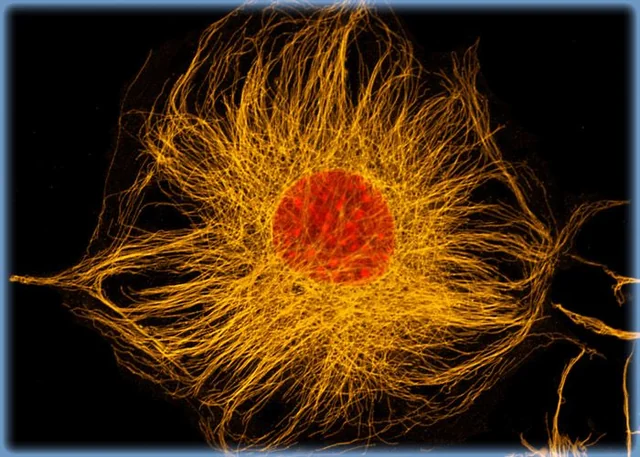
Introduction 
Definition: Autonopotent/Autonopotency - The state of high mental autonomy or act of potentiating mental autonomy / cognitive control.
PDE4D is part of the phosphodiesterase (PDE) family. A PDE is an enzyme that breaks a phosphodiester bond, with PDEs being classed into 11 groups in mammals (PDE1-11), and various subgroups. PDE4 is the primary cAMP-specific hydrolase and is represented by four genes (PDE4A, B, C and D).
You may have heard of PDE5i (inhibiting) compounds before (e.g sildenafil, tadalafil), however PDE4 and its subunit PDE4D have a completely different function than PDE5.
PDE4 / PDE4D inhibition has been shown to be procognitive in many studies [13][23]. Rolipram has been the key PDE4 modulating compound used to show efficacy, but it has had issues (e.g emesis, GI issues) which do not make it an optimal candidate for cognitive enhancement. On top of its unselectivity for PDE4 subgroups, it is also not selective for PDE4D isoforms unlike other inhibitors (mentioned later) and it is a full inhibitor, not a NAM (Negative Allosteric Modulator).
No PDE4 inhibitors have yet been brought to market because of issues related to tolerability. However, more targeted PDE4 modulators (e.g PDE4D3+PDE4D7 NAMs), avoid emesis and other issues practically completely in studies available.
The PDE4 inhibitors that have been explored in human clinical trials bind the active site competitively with cAMP and therefore completely inhibit enzyme activity at high concentrations. Although this traditional approach to PDE4 inhibitor design has demonstrated therapeutic benefit, competitive inhibitors are likely to alter cAMP concentrations beyond normal physiological levels, perturbing the tight temporal and spatial control of cAMP signaling within cells and leading to side effects.
PDE4D mutations have been found in genomic studies to be associated with major mental illness such as schizophrenia and poor general cognition [22]. This is consistent with other dlPFC-impacting genes, such as FOLH1 and GRM3.
High-Order Cognition (Autonopotency) Enhancement 
The role of PDE4D in regulating neurite outgrowth was supported by the localization of PDE4D protein in growth cones and the fact that many of known PDE4D-interacting proteins are involved in neuron projection development. As PDE4D was also found to localize to Microtubles in neurons of the macaque prefrontal cortex, which could be reason for its significance in cognitive ability when modulated. After more research into the receptors and proteins PDE4D interacts with, its direct involvement in microtuble modulation is much more relevant than previously thought.
PDE4D mRNA (and consequently protein expression) is also located highly in pyrimidial cells in humans [1], in the dlPFC specifically.
"The mean PDE4D mRNA expression averaged across probes within each subject in pyramidal cells (5.77 ± 0.54) was significantly ∼3-fold higher (p < 0.001; q < 0.001) compared to PV interneurons, indicating significantly greater expression of PDE4D mRNA in pyramidal cells from the same subjects" [1].
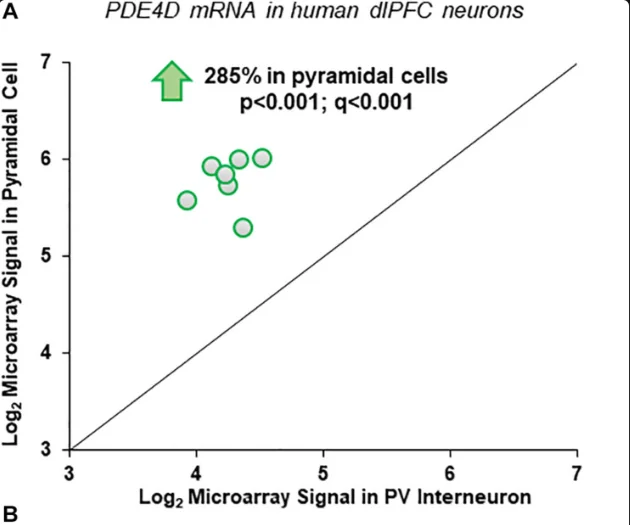
If you have read previous posts about the dlPFC or GCP-II, you may know the relevance of pyrimidal cells and the dlPFC (dorsolateral prefrontal cortex). The dlPFC is the center of a huge amount of important cognitive processes, such as consciousess, self-control, high-level cognition, working memory, and much more. It is an area of the brain super-localised with pyrimidal neurons [3][4], and the special density of pyrimidal neurons in the area is thought to underlie its special functionality and relevance.
As a note, rodents do not have rostral PFC areas (e.g. Frontal Pole) or a dlPFC, so it makes it more difficult to study due to the requirement for primates or humans to study upon.
Apart from the dlPFC, PDE4D is also relevant for other areas of the brain. For example, PDE4D KO significantly increases long-term memory, relevant in the hippocampus [2], and PDE4D also modulates the amygdala. Interestingly PDE4D KO actually reduces fear-conditioned memory [5], suggesting PDE4D inhibition positively regulates higher cognitive areas (such as the dlPFC) while negatively impacting lower cognitive regions like the amygdala. This is probably a combination of higher cognitive regions inhibiting amygdala activity and also a direct interaction within the amygdala.
I have discussed the dlPFC in the GCP-II post before, but I would like to go over how it relates to the goal of cognitive enhancement and Autonopotency in the context of PDE4D.
It is a fallacy that hedonism (I am trying to stop using that word) is just an environmental/societal issue or exists just as a philosophy. It is very evident through studies differing genomic and EEG differences in dlPFC functionality that high-level cognitive centres, the dlPFC especially, determine how pleasure/short-minded an individual is. The dlPFC actually becomes more active during normative choice where goals are hedonistic and attributes conflict. Evidence accumulation, not ‘self-control’, explains dorsolateral prefrontal activation during normative choice. [10]
From this mentioned study ([10]) - "This account draws on prior research in both perceptual and value-based decision making, which consistently finds that the posterior dlPFC region associated with both normative ‘self-control success’ and inhibitory control tasks also activates during choices that are more difficult to discriminate in simple perceptual and value-based choices lacking a self-control conflict"
A "strong" dlPFC is able to override lower brain regions when needed (such as the amygdala) to inhibit choices that won't be beneficial to the "higher mind". As it is strong, it does not require much processing, so paradoxically people with weaker dlPFCs have more activation during choices, also likely leading to increased glutamate-fatigue due to the constant rumination (just a theory of mine), leading to even easier cyclic hedonistic-choicing as a result.
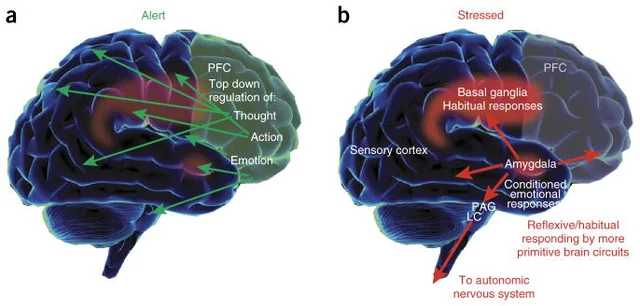
Enhancing the dlPFC over the whole prefrontal cortex is normally more desirable because you get a more selective outcome and also you don't enhance areas such as the OFC, which can be problematic if overactive (potentially leading to conditions such as OCD) [11][12]. Enhancing the dlPFC can actually bring brain regions back into a harmonic system, for example enhancing the dlPFC through different methods has been shown to reduce OCD phenology through overriding OFC (orbitofrontal cortex) activity.
The dlPFC is a major component of motivation/anticipation and goals. It integrates and transmits signals of reward to the mesolimbic and meso-cortical DA circuits and initiates motivated behavior [18]. The dlPFC-amygdala connection is almost like the the "gatekeeper" of the brain.
I don't like mixing in too much subjectivity into very scientific posts, but I want to go on a bit of a tangent. I think it is clear that humans have evolved from a pleasure-minded animals into things capable of thinking longer term, designing beauty, solving complex problems, etc. We are no longer limited by being on the edge of survival, and so all forms of art have flourished. However, in this transitory period, corrupted by parasitic individuals who take advantage of the easy-to-manipulate human mind, primitive thinking is still dominant in society. Society is just an average of people's internal states, and it is easy to say that the average internal state does not have great top-down control and cognitive agency. PDE4D is relevant to this because it is one of the few targets within the brain with the potential to change the balance of autonomy within an individual and society at a larger scale (due to its selectivity). This is incredibly valuable and also it is very rare to find such a target.
Isoform Selectivity and Microtuble Modulation 
There is another layer of complexity to PDE4D. PDE4D has 9 isoforms (PDE4D1-PDE4D9).
Longer PDE4D isoforms (such as D3, D7, D9) have been shown to have more importance to cognition than other smaller isoforms. Inhibition of longer isoforms has been shown to increase neurite length very significantly [6], while for shorter isoforms the increase is unsignificant.
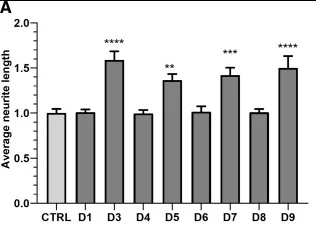
A large part of their importance comes from the way they interact with microtubles - "Immunocytochemistry and transfection studies demonstrate colocalization of PDE4D and myomegalin in the Golgi/centrosomal area of cultured cells." [9]
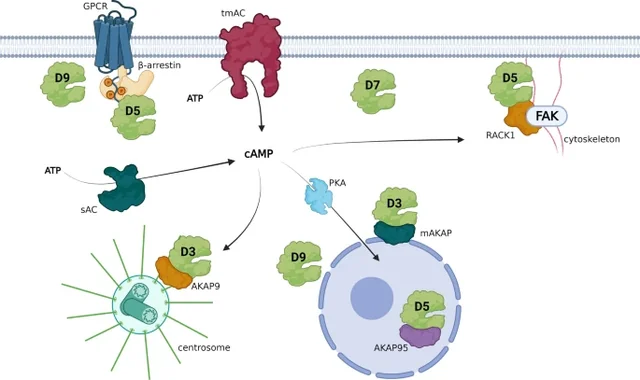
Microtubules are polymers of tubulin that form part of the cytoskeleton and provide structure and shape to eukaryotic cells. (*To be honest, I really need to make a dedicated post to emphasise the importance of understanding microtubles as a method of discovering novel cognitive enhancing pathways)
The specific isoforms of PDE4D also form different interactions with microtubles. PDE4D3 is known to interact with the centrosome (via AKAP9) and Pericentriolar Matrix, with inhibition of the isoform leading to enhanced microtuble nucleation and stability. On top of that, it is known to interact with the microtuble-associated protein called myomegalin, AKA PDE4DIP.
"Microtubule arrays are generated with the help of microtubule organizing centers (MTOC). MTOCs typically combine two principal activities, the de novo formation of microtubules, termed nucleation, and the immobilization of one of the two ends of microtubules, termed anchoring." [7] Local MTOC (Microtubule organizing center) nucleated microtubule arrays could act as positional cues to guide dendrite growth, branch formation, and arbor patterning.
This means PDE4D is one of the only pathways known that directly modulates golgi-associated proteins [19], which if you don't know is an incredibly important low level process underlying cognitive ability and consciousness It is most likely a key component of the golgi apperatus, due to PDE4DIP's relevance to neuronal development [17].
Golgi outpost-associated MT nucleation regulates distal dendritic branching and is critical for terminal branch stabilization. It is worth mentioning that Golgi outposts are absent in the axon, which is a long primary branch with uniform MT polarity. [15]
The subcellular localization of PDE4D within dendrites suggests multiple potential functions. The dense labeling near microtubules suggests that PDE4D is not simply trafficking on microtubules, but is likely regulating microtubule dynamics and/or trafficking along bundles.
"SWIM analysis identified several switch genes associated with gene expression changes in AD, VaD, and FTD. PDE4DIP, also called myomegalin, is the only switch gene that is shared among the dementias. The protein encoded by PDE4DIP is responsible for anchoring PDE4D to the Golgi/centrosome of cells and promotes microtubule assembly" [17]
Myomegalin is necessary for the sufficient growth of microtubules from the centrosomes. Myomegalin-depleted cells have slower migration, since microtubules are crucial for cell motility. The CM-MMG isoform binds at the centrosome with γ-tubulin in an AKAP9-dependent (AKA AKAP450) manner and on the near side of the Golgi apparatus, while the EB-MMG isoform binds with MAPRE1 at the Golgi apparatus and increases MAPRE1's effects on microtubule growth. [8]
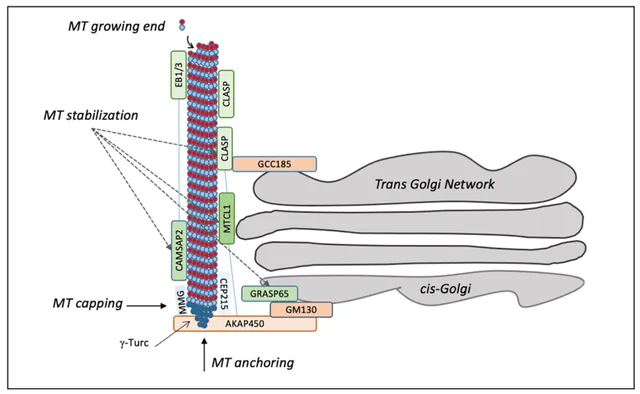
PDE4DIP is a paralogue of CDK5Rap2, which is another very important MAP (Microtuble Associated Protein) required for the nucleation (creation) of microtubles. It is quite a new (in medical terms) discovery, only being discovered around the year 2000, meaning there is not much research on MAPs compared to other cognitive components.
There are also the microtuble associated proteins MAP1, MAP2 and MAP4. However, as far as I am aware, PDE4D does not have much of a direct interaction with them.
The specific isoform PDE4D3 is tethered to the centrosome by Myomegalin (Mmg). Myomegalin is a centrosomal protein but has an expression pattern that is predominantly complementary to CDK5RAP2. Therefore, assuming a functional homology with Cnn, CDK5RAP2 may have two non- redundant roles in neurogenesis: to enhance the production of centrosomal microtubules and to exert a negative control over CDK5. [17]
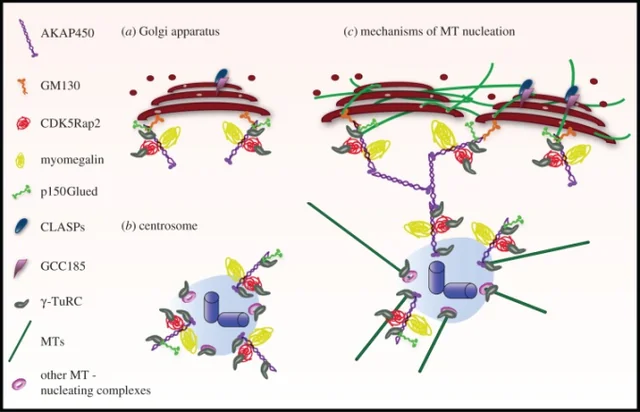
Long-form variants (e.g -3, -7) of PDE4D are already decreased in AD, and are associated with all types of dementia. This proves on top of being a highly relevant target for healthy individuals, it also is relevant for those suffering from age-related neurological conditions. On top of GCP-II inhibition, it may be a very effective pathway, especially considering PDE4D's direct interaction with MAPs (microtubles are dysfunctional in dementia for example).
On top of that, PDE4D inhibition has been found to promote myelin repair [21], which could help in conditions like huntington's disease, multiple sclerosis, and also conditions with oligodendrocyte/myelin dysfunctions. The -3 isoform specifically has also been found to be implicated in Alzheimer's disease [24][25].
On top of PDE4D modulating PDE4DIP, it binding with AKAP9 (AKAP450) also most likely means it modulates CDK5Rap2 to a moderately significant degree as AKAP450 interacts with it. If you want to know how significant CDK5Rap2 (PDE4IP paralogue) is, deficits in it are known to lead to microcephaly (very small head size) and seckel syndrome [27]. It is known to be relevant to layer II/III cortex especially [28].
CDK5Rap2, and myomegalin similarly are thought to be brain size regulator genes, which have evolved in expression across species and subtypes [29].
Centrosomal MT nucleation (creation) is mediated by a large protein complex named the g-tubulin ring complex (g-TuRC). AKAP450 and both pericentrin isoforms (A and B) interact with GCP2/GCP3 components of g-TuRCs. [15]
The primary MT-organizing centre in proliferating animal cells is the centrosome. However, the discovery of MT nucleation capacity of the Golgi apparatus (GA) has substantially changed our understanding of MT network organization in interphase cells. Interestingly, MT nucleation at the Golgi apparently relies on multiprotein complexes (PDE4DIP/myomegalin & CDK5Rap2), similar to those present at the centrosome, that assemble at the cis-face of the organelle. In this process, AKAP450 plays a central role, acting as a scaffold to recruit other centrosomal proteins important for MT generation. [15]
Golgi Apperatus 
The Golgi apperatus is also very important for hippocampal neurons [16] and neurons across the wholebrain. It serves as a microtubule-organizing center (MTOC) in addition to the centrosome in mammalian cells. The GA nucleates microtubules (MTs) from multiprotein complexes assembled at its cis-face.
MTs nucleated from the GA and centrosome differ in their geometry and post-translational modifications. GA-derived MTs are essential for Golgi ribbon formation and directional post-Golgi trafficking, while centrosomal MTs primarily determine GA pericentrosomal positioning.
In specialized cells like skeletal muscle fibers and neurons, GA-associated MT nucleation is crucial for the formation of non-centrosomal MT arrays with mixed polarity that support complex cytoarchitectural organization and functions. The PCM proteins pericentrin and AKAP450/CDK5Rap2 are implicated in this process.[15]
Negative Allosteric Modulation of PDE4D 
NAMs of PDE4D have shown a superior profile over generic inhibitors of the orthosteric site, as they only inhibit with an Imax of ∼80–90%. This is better than generic inhibition, because on top of the superiority of allosteric action (leading to a hypothetical positive allosteric action of MAPs also), it leaves some PDE4D available, which is good as it still is needed in small amounts for some bodily/cognitive processes. Complete inhibition has been found in studies to be typically less desirable. NAMs like D159687 and D159797 have been found to be very effective as a nootropic in studies on primates and rodents.
In one study [13] on Female Cynomolgus Monkeys, PDE4D (-3, -7 selective) NAMs significantly enhanced spatial cognition, increased memory retention and significantly decreased wrong answers in testing.
This study examined the pro-cognitive effects of two novel, selective phosphodiesterase 4D (PDE4D) negative allosteric modulators (NAMs), D159687 and D159797, in female cynomolgus macaques using an object retrieval (OR) task. The OR task assesses fronto-striatal function and is sensitive to dopaminergic and serotonergic manipulations. Rolipram, a non-selective PDE4 inhibitor, served as a positive control.
D159687 was efficacious at oral doses ≥0.5 mg/kg without adverse effects up to 5 mg/kg, indicating a therapeutic index >20. D159797 showed efficacy at ≥0.5 mg/kg but induced emesis at ≥1.5 mg/kg, suggesting a narrower therapeutic window.
In summary, this study demonstrates the pro-cognitive potential of selective PDE4D NAMs in a translational primate model of fronto-striatal function. D159687 exhibited a superior therapeutic index and is a promising candidate for further development. Establishing PK/PD relationships and target occupancy will aid in optimal dosing and clinical translation for neuropsychiatric disorders involving cognitive dysfunction.
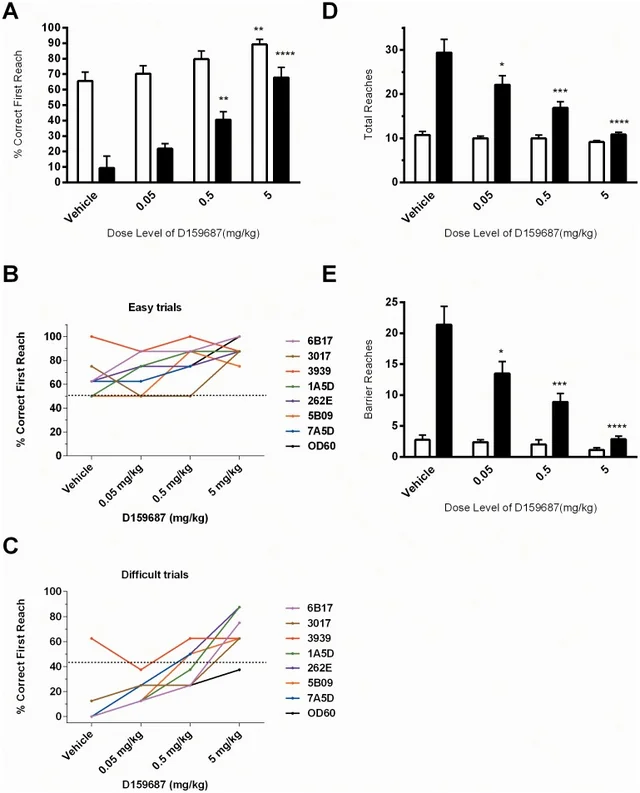
It should also be remembered than humans have more evolved pyrimidal neurons compared to primates and rodents especially, so the human-response to compounds modulating them may be emphasized in humans depending on the pathway.
Microtubles and Orch OR 
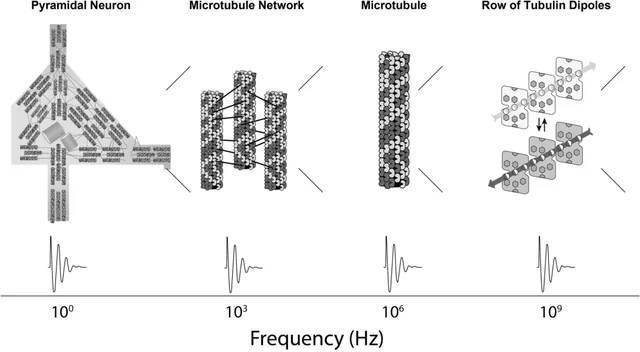
In the early 1990's, Roger Penrose and Stuart Hameroff created a hypothesis named Orchestrated objective reduction or AKA Orch OR. It is a theory which postulates that consciousness originates at the quantum level inside neurons, rather than the view that it is a product of connections between neurons.
Hameroff proposed that microtubules were suitable candidates for quantum processing, functioning as quantum logic gates that self-arrange in highly complex networks to underlie the basis of consciousness. [14]
It is a quite complex theory so you can visit the wikipedia or node of Orch OR for more info.
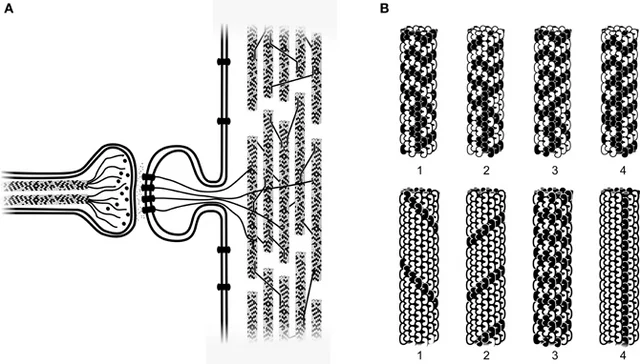
It makes modulating PDE4D even more interesting because we know it interacts with myomegalin, which modulates microtuble nucleation and stability directly in a centrosomal and golgi-dependent manner. Unfortunately, as far as I am aware, there are no studies yet looking into the effect of PDE4D inhibitors on microtuble arrangements, only KO models or using unselective compounds.
While the theory of Orch OR is still debated, it is known that microtubles have very special properties.
"A shared feature among all microtubule (MT)-dependent processes is the requirement for MTs to be organized in arrays of defined geometry. At a fundamental level, this is achieved by precisely controlling the timing and localization of the nucleation events that give rise to new MTs". [15]
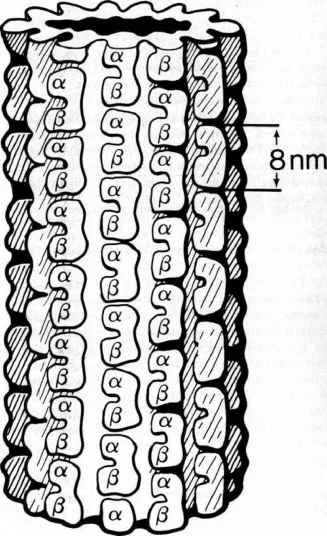
Recap 
In this writeup, we delved into the specifics of PDE4D and its isoforms, highlighting their importance as a promising target for cognition enhancement. PDE4D plays a crucial role in regulating cAMP levels in the brain, particularly in the dorsolateral prefrontal cortex (dlPFC) and hippocampus.
Studies have shown that PDE4D inhibition can lead to procognitive effects, with specific isoforms like PDE4D3 and PDE4D7 being more relevant to cognition than others. These longer isoforms interact with microtubules and centrosomal proteins like myomegalin (PDE4DIP), which are essential for microtubule nucleation, stability, and overall cognitive function.
We also discussed the importance of the dlPFC in higher-order cognition and its role in overriding lower brain regions like the amygdala to make more beneficial choices. Enhancing dlPFC function through PDE4D modulation could potentially lead to increased cognitive control and Autonopotency.
Negative allosteric modulators (NAMs) of PDE4D have shown promise in animal studies, with such compounds demonstrating procognitive effects without the side effects associated with non-selective PDE4 inhibitors.
In conclusion, PDE4D and its isoforms represent a novel and promising target for cognitive enhancement, warranting further research to fully understand their potential and develop effective therapies for neuropsychiatric disorders involving cognitive dysfunction.
For other targets of PDE, PDE4B also looks interesting, and looks involved in other pathways PDE4D does not effect. Also, PDE4D9 modulators look relatively unexplored as well.
Final Notes 
Thank you for reading to the end (or scrolling to the end) of this writeup. I know that in a few months I will probably look at this post again and see a bunch more I can add to it (and probably will) however, I am relatively happy with what it goes over for now.
Thank you for reading.